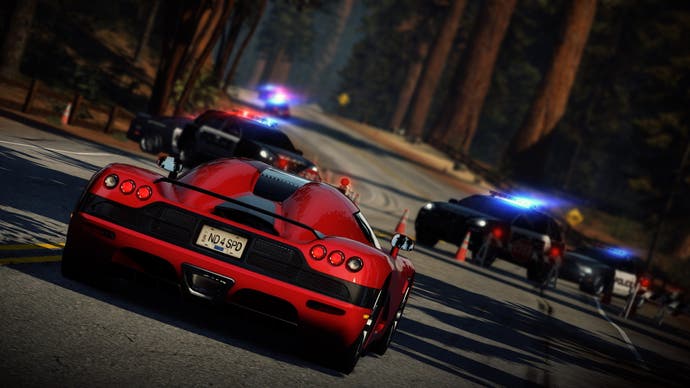How DICE collaborated on Need for Speed's game world
Battlefield devs join Criterion on Hot Pursuit.
Need for Speed: Hot Pursuit is set to take centrestage at EA's press conference next Tuesday at gamescom, but what you may not know is that Mirror's Edge and Battlefield developer DICE has worked closely with Criterion in building the new racer's massive open world. Speaking to Digital Foundry during our recent studio visit, key Criterion staff talked in-depth about Need for Speed's Swedish connection.
Faced with the task of creating an in-game map four times the size of Burnout Paradise's city, the small Guildford based studio called upon the might of the 200-strong DICE in order to lend a hand in creating a world massively divorced in terms of style and make-up from Criterion's previous Burnout work.
Art director Henry LaBounta is an ILM alumnus who has contributed to previous Need for Speed titles including Hot Pursuit 2 and Most Wanted. He joined up with Criterion for the new project and as you might expect, he is very enthusiastic about the partnership with DICE.
"It's been a great collaboration actually. Early on we set style guides for what we wanted to create out of this game, to offer players the ability to see a wide variety of types of environments from the deserts to the mountains to the forest to the coastal routes and so forth," he explains.
"We started talking to them about what we wanted to do and they got excited about the project; they have a very talented team of artists at DICE led by Johannes Söderqvist, their art director. We created all the roads here, we did a lot of work to get the gameplay right before we made it look pretty. They took those roads and those style guides and delivered 110 per cent on what we were looking for with the final result."
"The DICE guys... I'm not entirely sure how many artists they've had working on this but it's around 15-25 I think. It's not a huge amount of artists, but they've done a great job," says Criterion senior engineer Alex Fry.
"We designed the world here, handling guys and the world artists worked together to make sure the game world drives well and feels right. Once we finessed that and locked all the roads down, Henry set out the art style and how this game was going to look. Then we built in core locations... this is going to be seaside, this is going to be the mountain range, we wanted a bridge here... we mapped out the rough lay of the land and then DICE with our art director went in and turned it into something beautiful."


The brief presented to DICE was all about creating a game world that represented the ultimate in driveability while at the same time showcasing the beauty of the cars - the first time that Criterion has used real life licensed vehicles in one of their games.
"In our creative brief we were going for this concept of 'Need for Speed meets high-end car commercials', so if you look at any advertising for high end cars, you'll often see this exotic car on a desert road and it looks absolutely fantastic," reveals LaBounta.
"The goal for us is that the cars are the stars of this game. You get this beautiful organic scenery behind you and a nice contrast for that is this ultimate driving machine, the ultimate in engineering up against this organic environment. In the style guide we made sure it was all about recreating the moment of showing the car at its best. If you're Lamborghini and you're showing your car you want to do in the best possible way. What do they do? Well they go out to this gorgeous desert road and they shoot their car. Hmmmm, we could learn something from this and it fit really well with the concept of Hot Pursuit."
The notion of having the new Need for Speed built in two separate locations was definitely something of a logistical challenge, but big budget game developers like Criterion are no strangers to the idea of working with contractors and outsourcers.
"We outsourced more of Paradise than we did with Need for Speed because we don't consider DICE outsourcers, they're definitely working with us on this one," says Alex Fry.
"We've had our guys living in Sweden and Swedish guys coming here. We've had people from Black Box come... we definitely worked hard on getting this game useable from a variety of locations. Our lead technical artist moved to Sweden and worked with their senior technical artist, so those two guys together worked with myself and the graphics coders and the world artists that were here."
It's clear that Henry LaBounta's focus has been on generating environments separate and distinct from both Burnout Paradise and the modern day Black Box incarnations of Need of Speed. Indeed, the overall look of Hot Pursuit is very evocative of the classic NFS titles, and you can't help but wonder how much the spirit of the older games helped define the game world the DICE has helped to create.
"We do have some towns and stuff in here but this is about driving on the ultimate roads with these really powerful machines - the last place you want to do that is in a city," he explains.
"In general, in Need for Speed in the past, putting the game in a city has been really challenging because if you want to make it a convincing city with a city grid, that's not going to be much fun to drive so you end up having to bend the roads round and the city looks a bit odd. It doesn't make the game more fun to play having buildings all around. I actually think getting the road splines perfect is the key to making the games fun."

